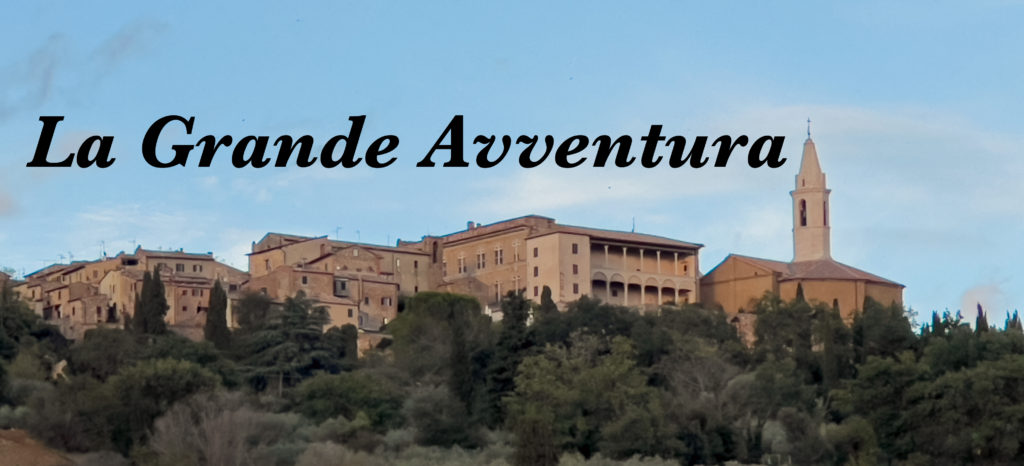
About 70 km southwest of Pienza lies the town of Sovana in a landscape of deep gorges and steep cliffs. The scenery is stunning, but that’s not the reason most people come to visit.
At one set of cliffs lies an archeological park called the “Citta del Tufo,” named for the type of rock in which the Etruscans carved their tombs.


The park is riddled with man-made caves that served as tombs for the Etruscans, the people who once lived here.
(Legend says the Etruscans were the descendants of Aeneas and his men, who fled Troy when the Greeks over-ran the city. (See the April 2014 post “Before the Romans“)
Many of the tombs are accessible to visitors, though their contents were either looted centuries ago or moved to museums.


One of the more notable graves is called Tombe Tifono…named after the mythical sea monster who the Etruscans believed caused typhoons.
The weather has been hard on the tomb over the past 2,500 years, but if you look closely, you can still see…

The remains of the face of the god Tifono, whose image was carved above the entrance of the tomb.



The remains of frescoes that had been painted on the ceiling of the tomb. And..

The steps the Etruscans built, so they could climb to the ledge above the cave…a place where archeologists found the burnt remains of sacrifices the ancients made to Tifono.


The archeologist Ranuccio Brandinelli was responsible for most of the excavations around Sovana. He worked from the 1920’s through the 1950’s discovering, documenting, restoring, and then archiving what he found at Citta del Tufo.
Most of what he found is today displayed at the Museo Mamiliano a few kilometers away in the town of Sovana…
…including a photo of the remains of one of the people buried in one the graves.


Perhaps the single richest source of artifacts in the museum came from the Tomb of Hildabrandt, which…when we visited it…had clearly had all its artifacts removed.
While the cave today is a barren cube hewn out of solid rock…
…it was once decorated with a complex terra cotta façade.

It contained mementos of earthly life…so the deceased’s spirit would have company in the hereafter.



…including household items…
…all 3 millennia old…
…like this bronze knife…


…and bronze comb.
Some things never change…
Even 3,000 years ago, the Etruscans needed to grate their cheese.


Most of the pottery was found as shards and meticulously pieced back together.
Look closely and see how the archeologists rebuilt this wine bowl.

Some of the metal pots show remarkable sophistication and detail for something produced in the prehistoric Bronze Age.
But the real star exhibit in the museum is these two figures. They were cast in lead and show remarkable realism for figures manufactured around 300 BCE.
They are part of a curious mystery. The tomb in which they were found dates to four hundred years before these figures were produced. Whoever made them, broke into that tomb and placed them next to a grave without stealing or disturbing any of the other items. Archeologists have no idea why.


Not all of the tombs at Citta del Tufo were discovered a century ago. In this picture, Carol is standing at the mouth of one of the largest tombs at the park. It was only unearthed in 2004.
Beside the large statue of a woman guarding the entrance, there is another of a headless animal…

…and inside the tomb a reclining woman…


It is named the Tomb of the Winged Demons, after this figure. The winged mermaid with two tails was a recurring theme in Etruscan mythology…and one that endured for centuries…even into the Christian era.
This same figure appears on the doorway of the Sovana cathedral…and on a Pienza church located adjacent to an Etruscan archeological village…and at the monastery of San Antimo.

All we saw really blew our minds. However, the caves and artifacts from the Citta delTufo told archeologists how the Etruscans dealt with death and religion, but not as much about how they lived.
For that, we had to go 150 km north…to the town of Murlo.

In the late 1960’s a group of archeologists (some from the University of Massachusetts) began excavating a wooded hilltop next to the town.
What they found filled in huge gaps in their knowledge.
The site contained the footings for a large home and a nearby workshop. A fire had destroyed the original house. The family that lived there rebuilt on the same site several years later, thus providing two sets of artifacts from Etruscan domestic life.

This picture reproduces what the archeologists learned. The open-air workshop contained…among other things…a foundry, showing how the Etruscans refined ore and cast their bronze and lead utensils.

The Murlo museum has tools in metal, stone, and bone taken from the work area. They tell us how the residents manufactured what they needed for daily life.
The archeologists found enough building fragments to piece together the roof of a house…a terra cotta frieze under the eaves of the roof, a terra cotta gutter, and a system of interlocking terra cotta roof tiles that’s still used today.

In addition, they discovered that these Etruscans placed statuary along the peak of the roof.

One of those statues was so unique, he became the symbol of the Commune of Murlo.
